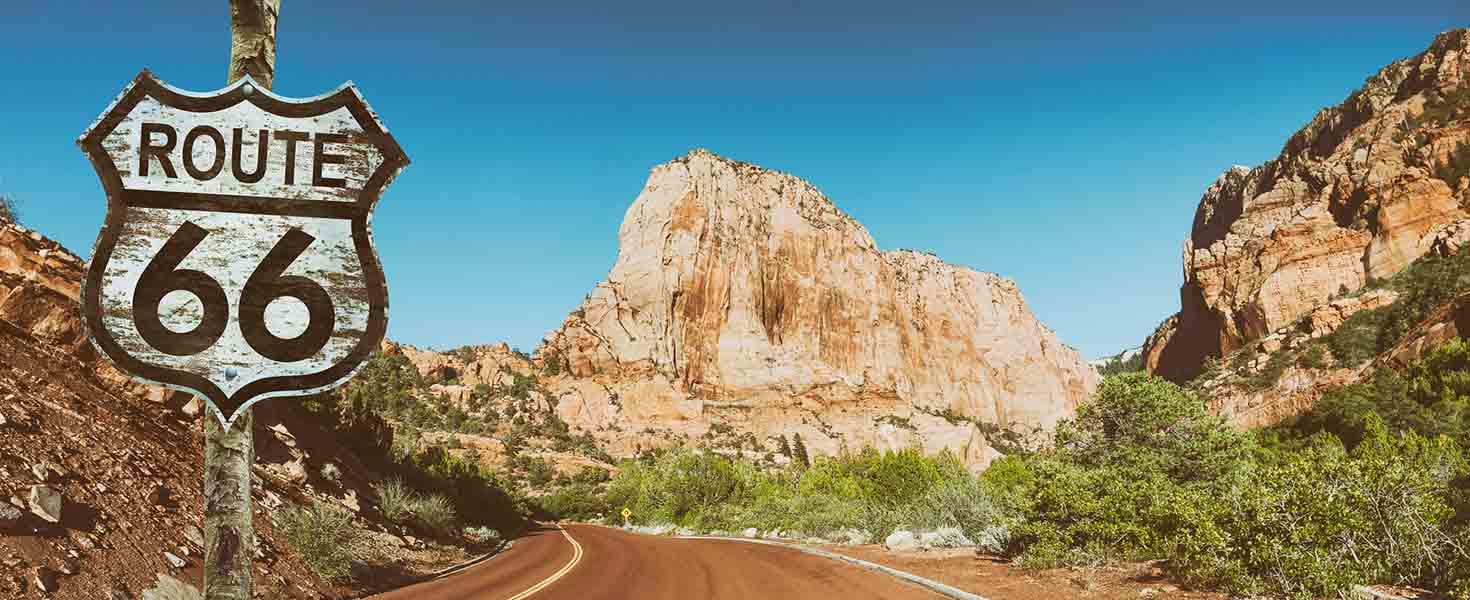

Get ready for the adventure of a lifetime on Route 66. Established in 1926, this “Main Street of America” is a still-thriving relic from days when Interstate highways didn’t yet zig-zag across the country, and airplane travel wasn’t yet mainstream. Travel moved at a slower pace, and Route 66 beckons you to do the same today. Don’t rush it.
What awaits on this 2,000-plus-mile journey from Chicago to California spans the spectrum as it weaves through some 200 small towns, across plains, mesas, forests, and deserts, immersing you into parts of the world that you might never experience otherwise. It’s a road trip menagerie of Americana filled with the beautiful, the quirky, the folksy, the historic, the curious, and the awe-inspiring—with each day flowering forth hundreds of mini-adventures. Leaving space in the itinerary for spontaneity and unscripted discoveries is rewarded, as there are millions of reasons to pause along this drive—from old-school motels and vintage signage; to ghost towns and curious roadside stops; to the stunning evolution of natural landscapes.
While you can no longer drive the entire Route 66 uninterrupted without borrowing some miles on the interstate, large portions (about 85 percent) are maintained and drivable. Most recommend two weeks to a month to truly savor the experience, but you might also opt to drive smaller sections of the Mother Road. What follows are some highlights to ignite your road trip wanderlust, and take on the world’s most epic drive.
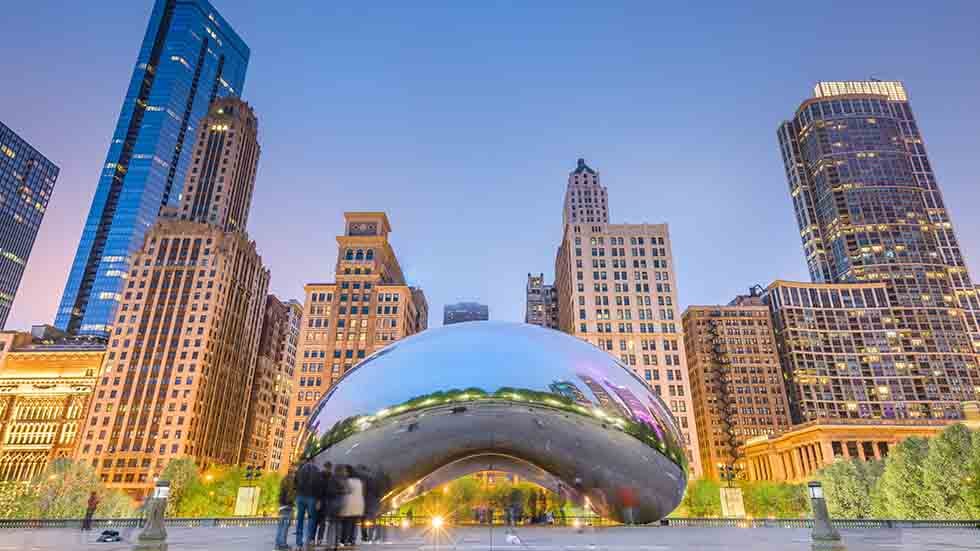
CHICAGO, ILLINOIS TO SPRINGFIELD, ILLINOIS
Chicago is the official starting point for Route 66. The city, however, is worth a few days of exploration before hitting the open road. This includes stepping onto The Ledge at Chicago Skydeck, a glass box that dangles 103 stories above buildings and streets, offering 360-degree views. From this vantage point, you can trace Route 66 as it heads out to the horizon and anticipate the adventure yet to come.
Before leaving skyscrapers behind for the expansive terrain of America, fuel up with a hearty breakfast at Lou Mitchell’s, a vintage diner that’s been feeding hungry travelers since 1923. With a full belly, you’ll leave the city in the rearview mirror to cruise through a Midwestern landscape of quiet farmland and prairies. Among the quirkiest attractions as you head into a conservative heartland—the Gemini Giant in Wilmington and its quasi-twin, the Hot Dog Muffler Man in Atlanta. Both are gigantic advertising props from the 1960s; today, one holds a rocket ship and the other holds a hot dog.
Pontiac is a can’t miss stop for its Route 66 Hall of Fame Museum and colorful murals dedicated to the Mother Road. So is Dwight, home to Ambler’s Texaco station, a well-preserved gas station relic from the 1940s that harkens back to Route 66’s heyday as a modern motor thoroughfare. Further south find Funks Grove, where the friendly Funk Family has been tapping trees and selling maple “sirup” since 1891.
As you continue deeper into Illinois, it’s hard to avoid references to the legend that gave the state its nickname, “Land of Lincoln.” In the aptly named Lincoln, find The Railsplitter Covered Wagon, recognized by the Guinness Book of World Records as the largest covered wagon in the world at 24 feet tall. Abe sits up front reading a law book. More Abe-inspired adventures await as you roll into the Illinois capital of Springfield.
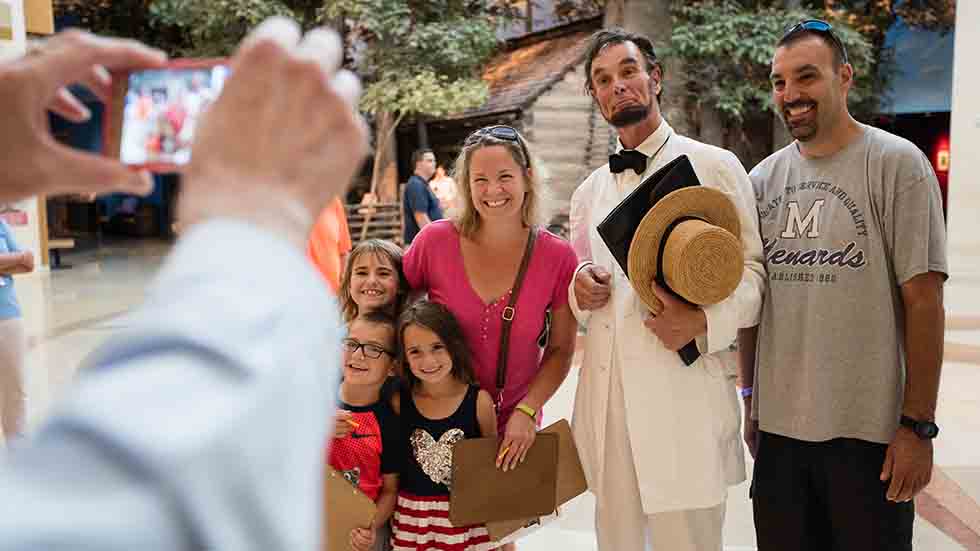
SPRINGFIELD, ILLINOIS TO ST. LOUIS, MISSOURI
In Springfield, dive into history predating Route 66. The Abraham Lincoln Presidential Library & Museum is an entertaining experience that traces the legacy of the 16th president of the United States, from his days as a young pioneer all the way to the presidency. His handwritten Gettysburg Address, the highlight for many who make the pilgrimage, is worth reading before heading back into town, where historical re-enactments take place in the summer months at landmark sites.
Before hitting the road, refuel with a not-so-nutritious meal at Cozy-Dog Drive In, which claims to be home of the original corn dog on a stick. Continuing south, you’ll steer through the town of Litchfield, an old coal-mining center now home to a lively flea market on summer weekends and the oldest restaurant on Route 66, the Ariston Café, a gem in the middle of the agricultural heartland.
Mt. Olive will greet you with the wonderfully restored Soulsby Service Station, a vintage Shell gas station where today’s drivers can stop for pictures. In Staunton, visit Henry’s Ra66it Ranch, the only Route 66 attraction with a singular focus on all things rabbit. This quirky stop features actual bunnies, Volkswagen Rabbits (anchored into the ground a la Stonehenge), and a giant fiberglass rabbit that you can ride.
More quirk awaits while passing through Collinsville—the World’s Largest Catsup Bottle, a water tower built in 1949 to resemble America’s No. 1 condiment. The nearby Cahokia Mounds State Historic Site doesn’t look like much—just massive grass-covered hills—but what resides at Cahokia are the remains of an ancient Native American city larger than London, dating back to AD 1250. The view from the top of 100-foot Monks Mound rewards with views of St. Louis, a city the ancients could have only dreamed of.
ST. LOUIS, MISSOURI TO SPRINGFIELD, MISSOURI
Before continuing onward from the “Gateway to the West,” head to the most famous arch that isn’t a part of any fast-food chain. On a clear day, you can see up to 30 miles in each direction from the top of the Gateway Arch. If you prefer to keep your feet on the ground, however, catch the St. Louis Cardinals at Busch Memorial Stadium, where baseball games are played against the backdrop of the Arch. It’s a quintessential Americana experience, even if you’re not a fan of baseball.
 World’s Largest Rocking Chair
World’s Largest Rocking ChairBeyond St. Louis, if you’ve ever wondered what the World’s Largest Rocking Chair might look like, you’ll find it in Fanning. It stands more than 40 feet tall in front of a kitschy souvenir stand that doubles as an archery supply store. Heading deeper into the Ozark Mountains stretch of Route 66, you’ll roll through Rolla, one of the region’s liveliest towns. It boasts the Totem Pole Trading Post, which has been in business since 1933 (no easy feat on a road once lined with numerous mom-and-pop businesses).
Stop in for local history and great memorabilia on display before setting off for Devil’s Elbow, considered one of the prettiest drives of Route 66—in part because much of the land is protected from development within the Mark Twain National Forest. The sleepy Ozark town is home to the Big Piney River and its scenic bluffs; an old steel bridge; and Sheldon’s Market, which doubles as the Devil’s Elbow Post Office. In Lebanon, find a well-regarded Route 66 Museum (located in the town library) and NASCAR stock car races at Lebanon I-44 Speedway.

If you’re up to exploring more Americana kitsch and have the time, Springfield makes an appropriate detour to Branson, the Ozark’s version of Las Vegas (read “wholesome”) and boasting more theater seats than Broadway in New York City. Shows such as “Dolly Parton’s Stampede” and “Legends in Concert” (featuring celebrity impersonators the likes of Elvis and Taylor Swift) can certainly add color to your Americana adventure.

SPRINGFIELD, MISSOURI TO OKLAHOMA CITY, OKLAHOMA
Leaving Springfield, the birthplace of Route 66, you’ll travel into the small Missouri towns of Carthage, which emulates Hill Valley from the Back to the Future movies, and Joplin, a former lead- and zinc-mining town, to reach Kansas. This is the shortest stretch of the old highway, not even 13 miles through the state. However, it packs a big punch in its towns of Galena, Riverton, and Baxter Springs thanks to enthusiastic local efforts to keep the Route 66 spirit alive and well-preserved. Among them is Cars on the Route, which is inside the old Kan-O-Tex gas station and sells sandwiches and souvenirs related to Pixar’s animated Route 66 movie Cars. It’s biggest point of pride is the early 1950’s tow truck that sits out front and said to be the inspiration for one of the film’s beloved characters, Tow Mater.
Entering Oklahoma brings you into a state with more still-drivable miles of the old highway than any other state, plus a bounty of folksy attractions that inspire stops. In Miami, check out the Route 66 Vintage Iron Motorcycle Museum, which features a fun room devoted to daredevil Evil Knievel. It includes artifacts from his world-famous stunts—and his corresponding X-rays.
In Vinita, time your trip to attend the Will Rogers Memorial Rodeo, held each August since 1935, or the World’s Largest Calf Fry Festival in late June. (Calf fries, also known as prairie oysters, are beef testicles. Just in case that wasn’t clear.) After passing the World’s Largest Totem Pole in Foyil and the Blue Whale of Catoosa, kitschy spots both worth a quick stop, you’ll arrive in Tulsa. Most of the fabulously preserved Art Deco architecture in this town was built during the 1920s boom years in the Oklahoma oil industry, with its Golden Driller statue proudly representing the city’s oil drilling legacy.
Heading west to Arcadia, The Round Barn, a beloved Route 66 landmark originally built in 1898, and POPS both beckon travelers to pull over. At Pops 66, sample some of the 700 types of soda while gassing up the car and gawking at its 66-foot-tall soda pop bottle illuminated by multicolored, energy-efficient LEDs. It’s quite a sight against the flat, dusty landscape just outside of Oklahoma City.
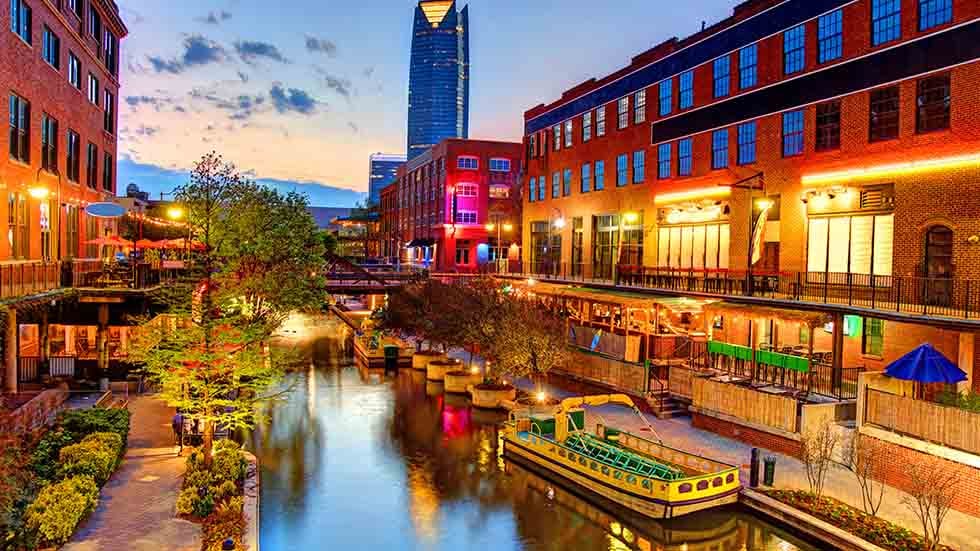
OKLAHOMA CITY, OKLAHOMA TO AMARILLO, TEXAS
Oklahoma City offers plenty of reasons to linger. The Bricktown Canal district makes for a fun night out, with its energetic atmosphere of restaurants, shopping, and the Chickasaw Bricktown Ballpark, home to the OCK Dodgers. For more of a pure Western experience, mosey over to the National Cowboy & Western Heritage Museum, an amazing curation of western art, plus movie, rodeo and cowboy history. It even has an entire room dedicated to the 8,000 different types of barbed wire.
Driving westward, stop in El Reno with a full stomach, assuming you’re not a vegetarian, because it’s home to the onion-fried burger. There are three well-regarded local joints where you can try it, all within a block of each other. Take your pick—Robert’s Grill, Sid’s Diner or Johnnie’s. On the first weekend in May, El Reno even cooks up the “World’s Largest Friend Onion Hamburger,” a 750-pound behemoth that inspires an all-day festival.
Continuing into the Texas Panhandle stretch of Route 66, you’ll enter a nearly 200-mile stretch of pancake-flat plains with rural towns like McLean, Shamrock, and Vega sprinkled in. All feature a cool collection of historic motels and gas stations. One of the standouts is the beautifully restored CONOCO Tower Station and U-Drop Inn Café, an Art Deco building dating back to the Great Depression and a landmark worshipped by Route 66 enthusiasts.
As you get closer to Amarillo, keep your eyes peeled for two towering landmarks punctuating the plains in Groom, Texas—a water tower that leans like the Tower of Pisa (aptly nicknamed “The Leaning Tower of Texas”) and a 19-story stainless steel cross (nicknamed the Groom Cross). Texas does like to do things big, after all.

AMARILLO, TEXAS TO ALBUQUERQUE, NEW MEXICO
It’s a bizarre sight just outside of downtown Amarillo—nearly a dozen Cadillacs have been upended into the Texas plains. Cadillac Ranch is a public art installation that was funded by an eccentric Amarillo helium millionaire who basically wanted to baffle and delight, and he certainly got his wish. Since it was erected in 1974, it’s achieved iconic Route 66 status thanks to photo essays, films, and social media. Bring a can of spray paint to make your mark on one of the Cadillacs – and take a photo, as whatever you create will likely only last a few hours before someone else sprays over it.
Before leaving Amarillo, drink with local cowboys and cowgirls at GoldenLight Café and Cantina, or perhaps accept a challenge—one not for the faint of heart or stomach—at Amarillo’s most famous steakhouse, Big Texan Steak Ranch. It famously offers a free 72-ounce steak, provided you eat it all, along with a salad, baked potato, and dessert, in under an hour. (Losers of this challenge ultimately owe $72 for the gargantuan-sized meal.)
Cruising through the rest of the Texas Panhandle, you’ll pass through Vega, the midway point of Route 66, before entering New Mexico. The Land of Enchantment weaves a special magic on those road tripping through its landscape of interesting topography that hosted many adventures of legendary outlaw Billy the Kid. Try to time a nighttime visit to Tucumcari—as it’s a treasure of kitschy shops, old-school diners, and vintage motels bearing sparkling neon signs. The Blue Swallow Motel and Tee Pee Curios are among the highlights in this once-thriving town that harbors of the ghosts of its glorious Route 66 past.
The Route 66 Auto Museum in Santa Rosa is worth a stop for car enthusiasts who want to ogle tricked out old Fords and Chevys; but if you haven’t yet had your fill of wacky roadside kitsch, visit the Tinkertown Museum just east of Albuquerque. It boasts a crazy amount of hand-carved animated figures, arranged in tiny stage sets, acting out animated themes—all built over the span of 50 years by one truly dedicated man.

ALBUQUERQUE, NEW MEXICO TO GALLUP, NEW MEXICO
The longest urban stretch of Route 66 flows 18 miles through the center of Albuquerque. Sparking neon signs, motels, and diners greet you in this vibrant, multicultural city where sampling its famous red and green chili-infused cuisine is a must. Stroll its Old Town to get a sense of New Mexico’s Spanish colonial past, and step into the American International Rattlesnake Museum for close encounters with the types of creatures you wouldn’t want to befriend alone in the desert.
A side trip north to Santa Fe is worth it, to meander the pedestrian-friendly downtown Plaza, where the Georgia O’Keefe Museum and savory breakfast quesadillas at Cafe Pasqual's tantalize all the senses in a setting that blends Old West with Spanish Colonial. Nearby Bandelier National Monument and Kasha-Katuwe Tent Rocks Monument (which is like a setting out of a Star Wars movie) offer spectacular hikes.
Back on Route 66, an hour west of Albuquerque, the Acoma Pueblo offers a window into Native American traditions and culture. You must join a guided tour to experience it. The oldest continuously inhabited community in North America, it’s built atop a 367-foot sandstone bluff in a valley surrounded with sacred, towering stones. Further down Route 66 is Grants, a former mining boomtown home where you can experience a simulated underground uranium mine at its New Mexico Mining Museum.
Just west of Malpais, reservations are necessary to visit the wolves that live at Wild Spirit Wolf Sanctuary, a 100-year-old ranch now dedicated to the rescue, sanctuary, and education of wolves. In Gallup, a city founded when the Santa Fe Railroad first rumbled through in 1881, you’ll find a cool strip of neon signs, making it worth timing an overnight here. Sleep where John Wayne slept —The El Rancho Hotel is a well-preserved 1930’s lodge-style hotel that’s over the years hosted Hollywood stars filming Westerns in the area.
GALLUP, NEW MEXICO TO FLAGSTAFF, ARIZONA
Time your trip accordingly and you could be a part of the biggest Native American gathering in the country. It’s held in Gallup each August. The Inter-Tribal Indian Ceremonial fills this Route 66 stretch with parades, a rodeo, and powwows.
From New Mexico crossing into Arizona, enjoy some of the longest still-drivable stretches of the Mother Road and move deeper into a landscape of Native American legacy and stunning red rock vistas. Plenty of dramatic scenery can be found at the Painted Desert and Petrified Forest National Park, the only national park that protects a portion of Route 66. Along this 28-mile stretch, the colorful, multihued mesas of the Painted Desert, specifically, will woo you to step out of your vehicle for a look-see or short hike.
In nearby Holbrook, chuckle at the “Sleep in Teepee” Wigwam Motel, an historic Route 66 motel in operation since 1950. Make a reservation if you’re curious to experience what it’s like to slumber in a giant concrete teepee. Coming into Winslow, crank up the Eagles on your car stereo. The center of town pays homage to the 1970’s Eagles song “Take it Easy,” with signage and motifs (including a legit flatbed Ford) that evoke a classic line from the song. It’s a fun photo opportunity—one of many to be found on Route 66.
Meteor Crater and Sunset Crater provide opportunities to traverse eerie landscapes created by meteor strikes into the Earth some 50,000 and 1,000 years ago, respectively. You can also step out of the car to explore another special landscape at Wupatki National Monument. Its 35,000 acres are home to hundreds of ruins of a prehistoric Native American community dating back to AD 1250. You can meander, climb, and imagine what life must have been like, residing in the quiet desert landscape northwest of Flagstaff, long before roads like Route 66 came into existence.
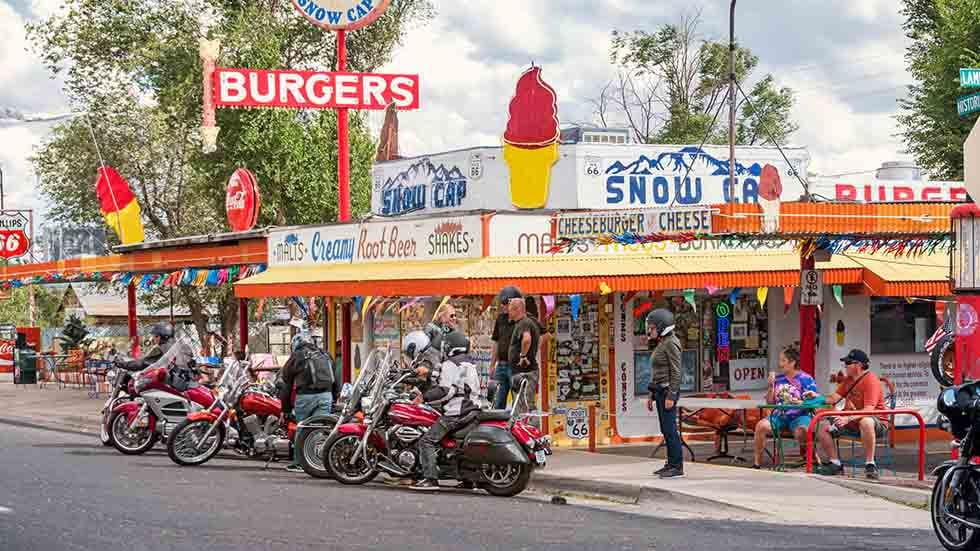
FLAGSTAFF, ARIZONA TO NEEDLES, CALIFORNIA
The old railroad and lumber-mill town of Flagstaff is today an energetic mountain town that attracts ski enthusiasts, mountain bikers, and craft beer connoisseurs. It’s also an appropriate jumping-off point to the Grand Canyon, certainly worth a day or a week, depending on your appetite for outdoor adventure. Alternatively, to the south of Flagstaff is Sedona, famous for its beautiful red rock formations, mystical vortex sites, and New Age spiritualism.
Continuing along the Mother Road west from Flagstaff, the town of Seligman is a 6.4-square-mile highlight packed with Route 66 enthusiasm. It’s somehow withstood the test of time, just as other boom towns along Route 66 went bust as the interstate highway system took over. “Radiator Springs” from the Pixar-animated film Cars is said to be based on Seligman. Its eclectic character shines through at spots such as The Rusty Bolt, an emporium of trinkets and odd junk, and Delgadillo’s Snow Cap Drive-In, where delicious green chili burgers are served with a side of corny jokes.
Traveling onward, Route 66 slices through the high desert along the Santa Fe Railroad tracks through abandoned towns to Kingman, which is an ideal spot to make a detour for a Las Vegas side trip. Otherwise, you’ll be treated to one of the kitschiest Old West sections of Route 66 by continuing onward to Oatman. To get there, you need to slowly traverse the mountainous switchbacks of the Sitgreaves Pass, preferably with daylight. It’s worth it. A one-time mining town, Oatman is straight out of Wild West movie set, with mock gunfights (for the tourists), and semi-tame burros (descendants of animals that once toiled in area gold mines) wandering its streets. Heading down into California, you’ll eventually arrive in Needles.

NEEDLES, CALIFORNIA TO SANTA MONICA, CALIFORNIA
In Needles, gas up and enjoy a home-style meal at the Wagon Wheel Restaurant, a favorite since the 1950s with locals, truckers, and Mother Road travelers, because the next part of Route 66 heads into a parched no man’s land—the Mojave Desert. While cruising this expansive, 80-mile stretch, keep eyes peeled for the Mojave Desert Guardian Lions, set back about 500 feet from the east side of the road several miles from Amboy. Nobody knows why or how – nor by whom – these massive marble enigmas were placed there. They are an unusual sight, silently guarding the quiet desert landscape.
Amboy, a town once listed for sale on eBay, is a ghost town with one attraction—Roy’s Motel and Cafe. It consists of a preserved motel (no longer taking guests), convenience store, and gas station with a retro sign iconic to Route 66.
Arrival in Barstow provides an opportunity to side-trip to Joshua Tree National Park, but if you continue onward to Oro Grande, you can visit a forest of bottle trees instead. Elmer’s Bottle Tree Ranch is a quirky, de facto art installation launched by a man who amassed a large collection of green, blue, brown, and clear glass bottles and turned it into one of Route 66’s most beloved stops. The throwback vibe of the Mother Road begins to fade as it winds into the modern suburban sprawl of San Bernardino and Pasadena, but a stop at the Original McDonald’s Site & Museum, a tiny treasure trove of fast-food memorabilia and history, can quickly recapture it.
Entering Los Angeles, old Route 66 follows Sunset Boulevard and Santa Monica Boulevard, finally to the Santa Monica Pier. This is where the “End of the Trail” Route 66 sign resides. Take a moment to imagine the thrills of early travelers from the Midwest who laid eyes on the Pacific Ocean for the first time, eager to start a new chapter in their lives. Reflecting upon your own yellow-brick-road journey across America, you’re likely to feel a respect and camaraderie that crosses generations—and gratitude for a chapter to be forever woven into your own life story.
